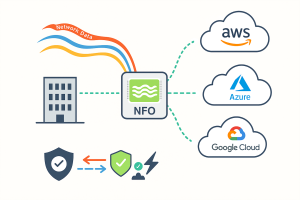Network monitoring has long been a crucial aspect of business operations, ensuring IT infrastructure functions smoothly and efficiently. It facilitates seamless communication, data transfer, and application performance. However, as modern IT environments become increasingly complex with the proliferation of cloud computing, virtualization, and the Internet of Things (IoT), traditional network monitoring methods are struggling to keep up. The sheer volume of data generated makes it challenging for human administrators to detect and resolve issues proactively.

The Rise of AI and Machine Learning in Network Monitoring
Artificial Intelligence (AI) and Machine Learning (ML) are transforming network monitoring by introducing automation, intelligence, and efficiency. These technologies empower organizations with deeper network insights, predictive analytics, and enhanced performance optimization. With the emergence of agentic AI, which can take autonomous actions, this transformation is reaching new levels of sophistication.
Challenges of Traditional Network Monitoring
Traditional network monitoring is heavily dependent on human intervention and rule-based systems, leading to several significant challenges:
- Data Overload: The sheer volume of network data overwhelms human analysts, making it difficult to identify critical issues amidst the noise.
- Slow Response Times: Manual troubleshooting delays response times, increasing the risk of prolonged downtime.
- Reactive Approach: Rule-based monitoring primarily alerts administrators after an issue has already occurred, rather than predicting potential problems.
- Difficulty in Anomaly Detection: Identifying unusual network behavior is challenging, especially in dynamic IT environments.
- Skill Shortages: Finding skilled network engineers capable of managing and analyzing complex networks is becoming increasingly difficult.
How AI and ML Are Transforming Network Monitoring
AI and ML address these challenges by offering:
- Automated Anomaly Detection: AI algorithms analyze vast amounts of network data in real time, detecting deviations from normal patterns and proactively addressing issues before they escalate.
- Predictive Maintenance: ML models analyze historical data to anticipate potential failures, such as bandwidth bottlenecks and hardware malfunctions. Cisco Catalyst™ Center leverages AI/ML to automate network operations and provide intelligent insights.
- Root Cause Analysis: AI quickly identifies the root cause of network issues, significantly reducing troubleshooting time.
- Intelligent Alerting: AI-powered monitoring prioritizes alerts based on severity, ensuring critical issues receive immediate attention.
- Enhanced Security: ML algorithms detect and mitigate cyber threats, including DDoS attacks and malware infections.
AI and ML Techniques in Network Monitoring
Several AI and ML techniques are being implemented to enhance network monitoring:
- Anomaly Detection: AI identifies unusual behaviors in network traffic to prevent failures and bottlenecks.
- Predictive Analytics: ML models analyze historical trends to forecast future issues and proactively mitigate them.
- Network Optimization: AI optimizes routing decisions, manages bandwidth, and reduces latency by identifying congestion points. Juniper Networks’ Mist AI platform, for example, enhances Wi-Fi performance through automation and intelligent analysis.
- Deep Learning: Neural networks analyze complex data patterns for deeper insights.
- Security Monitoring: AI-driven security systems detect malicious activity in network traffic, enabling faster threat response.
Agentic AI: The Next Evolution in Network Monitoring
Agentic AI advances traditional AI capabilities by not only analyzing data but also taking actions, interacting with the environment, and collaborating with human administrators. This evolution enhances network monitoring through:
- Self-Healing Networks: Agentic AI autonomously diagnoses and resolves network issues, ensuring minimal downtime.
- Automated Network Optimization: AI continuously monitors and adjusts configurations for optimal performance and security.
- Proactive Threat Response: AI neutralizes cyber threats before they cause significant damage.
- Intelligent Collaboration: AI partners with human administrators by providing actionable recommendations and automating complex tasks.
The Role of Enriched and Optimized NetFlow Data
AI and ML-driven network monitoring require high-quality input data, particularly enriched and optimized NetFlow data:
- Enriched NetFlow: Augmenting basic NetFlow records with contextual information, such as application, user, geolocation, and device identification.
- Optimized NetFlow: Enhancing data collection efficiency through aggregation, storage optimization, and normalization for seamless analysis.
Real-World Applications of AI and ML in Network Monitoring
- Performance Optimization: AI monitors network performance metrics like latency and packet loss, optimizing configurations for seamless operations.
- Capacity Planning: AI-driven forecasting helps organizations anticipate future network traffic demands and plan for upgrades.
- Security Threat Detection: ML algorithms effectively detect cyber threats, reducing response times and mitigating risks. Splunk’s Security Operations Center utilizes AI/ML for automated threat hunting and response.
- Incident Management: AI automates troubleshooting, reducing resolution time for network issues.
- IT Operations Automation: AI streamlines routine IT tasks such as device provisioning, firewall configuration, and network access management.
Benefits of AI and ML-Powered Network Monitoring
- Enhanced Visibility: Gain deeper insights into network behavior to prevent potential disruptions.
- Reduced Downtime: Minimize outages with predictive analytics and automated issue resolution.
- Improved Security: Detect and respond to threats in real time, safeguarding business assets.
- Increased Efficiency: Automate repetitive tasks, allowing IT teams to focus on strategic initiatives.
- Cost Optimization: Reduce operational expenses by eliminating inefficiencies and optimizing resource utilization.
Challenges and Considerations
Despite its advantages, AI and ML adoption in network monitoring comes with challenges:
- Data Quality: The accuracy of AI models depends on high-quality training data.
- Privacy and Security: Organizations must ensure compliance with data security regulations.
- Integration Complexity: AI solutions must seamlessly integrate with existing network monitoring tools.
- Skill Development: IT teams require training to effectively leverage AI and ML technologies.
- Explainability: Understanding AI decision-making processes is crucial for trust and accountability.
The Future of AI and ML in Network Monitoring
AI and ML will continue to shape the future of network monitoring by enabling:
- More Accurate Predictive Analytics: AI-driven forecasts will enhance proactive network management.
- Personalized and Context-Aware Monitoring: AI will offer customized network insights based on specific business needs.
- Autonomous Networks: Self-healing and self-optimizing networks will become more common.
- Innovative Network Architectures: AI will drive the evolution of smarter and more efficient network infrastructures.
Conclusion
AI and ML are revolutionizing network monitoring, providing unprecedented levels of automation, intelligence, and efficiency. By embracing these technologies, businesses can enhance network performance, bolster security, and streamline IT operations. With agentic AI on the horizon, network management is poised for even greater advancements. Organizations that invest in AI-powered monitoring and optimize their NetFlow data will gain a competitive edge in today’s rapidly evolving digital landscape.
About DT Asia
DT Asia began in 2007 with a clear mission to build the market entry for various pioneering IT security solutions from the US, Europe and Israel.
Today, DT Asia is a regional, value-added distributor of cybersecurity solutions providing cutting-edge technologies to key government organisations and top private sector clients including global banks and Fortune 500 companies. We have offices and partners around the Asia Pacific to better understand the markets and deliver localised solutions.
How we help
If you need to know more about The Future of Network Monitoring: How AI and Machine Learning Are Changing the Game, you’re in the right place, we’re here to help! DTA is Netflow Logic’s distributor, especially in Singapore and Asia, our technicians have deep experience on the product and relevant technologies you can always trust, we provide this product’s turnkey solutions, including consultation, deployment, and maintenance service.
Click here and here and here to know more: https://dtasiagroup.com/netflowlogic/










